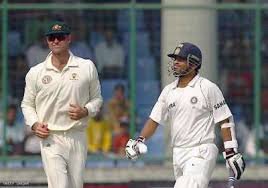As Team India grapples with scrutiny following the Melbourne Test loss in the ongoing Border-Gavaskar Trophy, the lessons from Sachin Tendulkar’s iconic 241* in Sydney during the 2003-04 series hold profound relevance. That knock was not merely a demonstration of skill but a testament to mental fortitude, self-discipline, and the ability to adapt to the game’s demands.

Sydney: The City of Cricketing Memories
Sydney is known for its iconic landmarks like the Opera House, Harbour Bridge, and Bondi Beach. However, for Indian cricket fans, it stands for something greater—the venue of Tendulkar’s unforgettable innings. The 241* remains one of his most fascinating knocks, showcasing not just his brilliance but also his ability to suppress instinct for the greater good of his team.
The Backstory: A Promise and a Challenge
In his autobiography Playing It My Way, Tendulkar shared the build-up to that knock. Frustrated by getting out after promising starts throughout the series, Tendulkar had a candid conversation with his brother, Ajit, who pointed out flaws in his shot selection. Determined to prove his resilience, Tendulkar vowed not to lose his wicket in the match.
The Australians, aware of Tendulkar’s proficiency with the cover drive, devised a plan to lure him outside the off-stump. Sensing this, Tendulkar made an extraordinary decision mid-innings: he would not play the cover drive at all. This wasn’t pre-planned but an instinctive move to counter the opposition’s strategy.
Mastery Through Restraint
Tendulkar’s innings was a study in patience and discipline. Across 436 balls and 613 minutes, he compiled a flawless double century without playing a single cover drive. Instead, he relied on cuts, flicks, and straight drives to accumulate runs, forcing the bowlers to adapt and eventually err.
Even Steve Waugh, captaining Australia in his final Test, hailed the knock as a lesson in mental strength. “He didn’t play the cover drive at all, which showed incredible discipline. That was a learning moment for me, even in my last match,” Waugh later admitted.
Lessons for Modern-Day India
The Sydney innings serves as a powerful example of how restraint can be a match-winning strategy. It wasn’t about avoiding shots entirely; it was about playing them at the right time and in the right context. This is a lesson that Rohit Sharma, Virat Kohli, and Rishabh Pant can take to heart after their dismissals in Melbourne.
Australia captain Pat Cummins summed it up after the Melbourne Test, noting that India’s inability to maintain composure during critical phases handed the game to Australia. “The first hour of the day really took the win out of the equation for them,” Cummins said.
In modern cricket, where audacious shots dominate the narrative, Tendulkar’s approach offers a timeless reminder: success often lies in knowing when not to attack.
Sydney: A Stage for Redemption
As the series moves to Sydney, India’s batters have a chance to redeem themselves, level the series, and retain the coveted trophy. Tendulkar’s epic stands as a beacon of inspiration—a reminder that greatness is not just about the shots you play but about the ones you choose to leave.
In the end, cricket remains as much a battle of the mind as it is of skill, and Tendulkar’s Sydney masterpiece is proof of that timeless truth. For Team India, the lessons of that innings could make all the difference.


